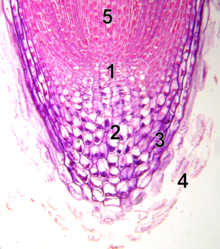Root cap
Appearance
| Root cap | |
|---|---|

| |
| Root tip magnified 100×. 1. Meristem 2. Columelle (statocytes with statolithes) 3. Lateral part of the tip 4. Dead cells 5. Elongation zone | |
| Scientific classification |
The root cap is a section of tissue at the tip of a plant root.[1] It is also called calyptra. Root caps contain statocytes which are involved in gravity perception in plants.[1] If the cap is carefully removed the root will grow randomly. The root cap protects the growing tip in plants.[1] It secretes mucilage to ease the movement of the root through soil,[1] and may also be involved in communication with the soil microbiota.[1]
The root cap is absent in some parasitic plants[2]: 138 and some aquatic plants, in which a sac-like structure called the root pocket may form instead.[3]: 2–76
References
- ^ a b c d e Raven, J.A.; Edwards, D. (2001). "Roots: evolutionary origins and biogeochemical significance". Journal of Experimental Botany. 52 (90001): 381–401. doi:10.1093/jexbot/52.suppl_1.381. PMID 11326045.
- ^ Jeffrey, Edward Charles (2007). The Anatomy of Woody Plants. Pomeroy, Ohio: Carpenter Press. ISBN 1-4067-1634-0.
- ^ Gupta, P.K. (2007). Genetics: Classical to Modern. Rastogi Publications. ISBN 978-8-1713-3896-2.
{{cite book}}: Cite has empty unknown parameter:|1=(help)
